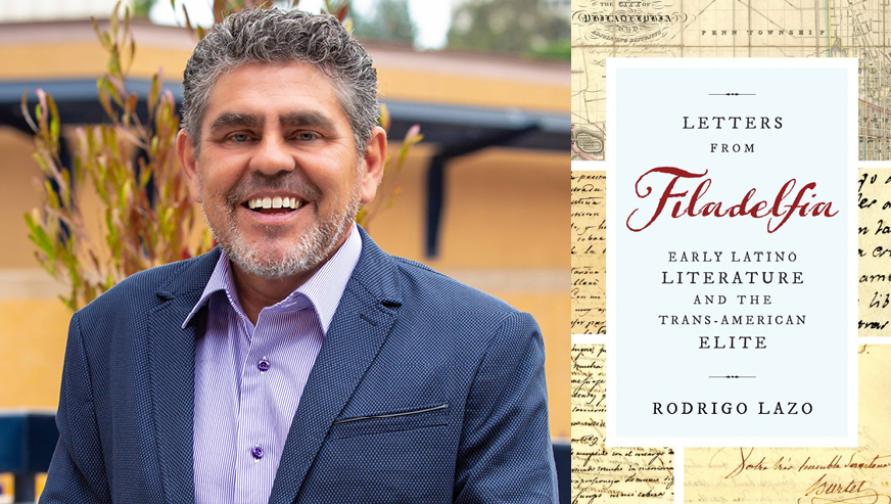
In his new book, Letters from Filadelfia: Early Latino Literature and the Trans-American Elite (University of Virginia Press, 2020), Rodrigo Lazo, professor of English at the University of California, Irvine, broadens the historical record of the original capital of the United States to include and showcase the contributions of Spanish-speaking intellectuals. Through translations of Spanish-language documents and letters, Lazo proves that the U.S. is not a monolingual country, neither historically nor today, as many would claim.
In the interview below, Lazo discusses his inspiration for the book, the power of translation and the multilingual history of Philadelphia.
What inspired you to write this book?
Some years ago, I became fascinated by the large number of Spanish-language materials (books, pamphlets, periodicals) published in Philadelphia early in the nineteenth century. Some people still want to see the United States as a monolingual, English-only country, but history shows that many languages have circulated around the territories that today make up the U.S., sometimes in unexpected places. I wanted to bring forward how important the crossing of languages was to this historical moment of independence movements across the Americas.
Your book is the first book-length study of Philadelphia publications by Spanish-speaking intellectuals such as Vicente Rocafuerte, José María Heredia, Manuel Torres, Juan Germán Roscio, and Servando Teresa de Mier. While doing your research, how did you narrow down your scholarship to these individuals?
They are some of the better-known historical figures that passed through or settled in Philadelphia and wrote or published while there. All of them have been claimed by their respective nations as historical actors – for example, Heredia as a poet of Cuba, Mier as a fighter for independence in Mexico. These nationalist perspectives often overlook or cut out altogether the way these figures moved across the Americas and that they had turned to Philadelphia. My scholarship is in part about situating intellectuals in new locations and thus changing the way we view America in the broader sense of the term.
How does your book re-frame or challenge what we think we know as the history of Philadelphia?
In a basic way, Philadelphia is associated with the U.S. Constitution, the Liberty Bell and Independence Hall. These are all related to the founding of the United States. But its history is much more complicated. Early on, the city also drew immigrants from around the world and included populations that spoke German, French and Spanish. These people plugged into the large number of printers in the city, and thus Philadelphia became an international city. Philadelphia’s printers were an important part of Spanish-language intellectual culture in the United States. As my book shows, the city stood for democratic movements across the Americas and other parts of the world.
Your book is largely an epistolary undertaking--translating Spanish-language letters by Philadelphia's movers and shakers. How did you approach the art of translation?
Throughout the book, I provide the Spanish original for quoted materials. That will allow people to check my translations, which are intended to make the argument of the book understandable to English-language readers. Interestingly, some of the writers I discuss in the book took up the politics of translation, meaning how it is used in political movements and how some discredit particular works by calling them “bad translations.” Maybe such a translation can inspire readers to come up with an alternate one. Many of us who live in the United States do so in more than one language, and translation, whether on paper or in our minds, is a part of everyday life.
In your opinion, can the Spanish-American influence still be felt in Philadelphia? If so, where would you recommend someone to go look?
Today they would be called Latinos/as or LatinX, and the city has large populations from Puerto Rico, the Dominican Republic, Mexico and other countries. The largest group is by far Puerto Ricans, as a result of migration processes from the late nineteenth century to World War II and beyond – a period outside the scope of my book. I hope that my book will provide important historical information so that it becomes apparent that people from Latin America are not newcomers to Philadelphia.
How does this reshape our understanding of early-U.S. history, especially since what's taught is so often dominated by the Founding Fathers?
Some might argue that the men in my book are founding fathers, just in different countries. I do bring up questions of gender wherever possible in the book, and my archive of texts shows that women were excluded from the elite male-centered circles of intellectual work. In terms of the larger issue about U.S. founding fathers, we need to continue to focus on alternate populations to get a more complete picture of historical panoramas.
What do you hope readers will take away from the book?
That depends on the reader. Some will take a new view of Philadelphia history. I hope some are reminded that the Spanish language is a very important part of U.S. history. For people who work in the field of LatinX studies, I hope they will see that when we approach other centuries, it is important to be very attentive to the socio-economic positions of historical figures. I also hope that some readers will be reminded how awesome hand-written letters can be. Letters can cross distance and build bridges across languages and cultures. Working on this book inspired me to return to writing letters by hand. I use a fountain pen.
Letters from Filadelfia: Early Latino Literature and the Trans-American Elite (Writing the Early Americas) is available February 24, 2020.
